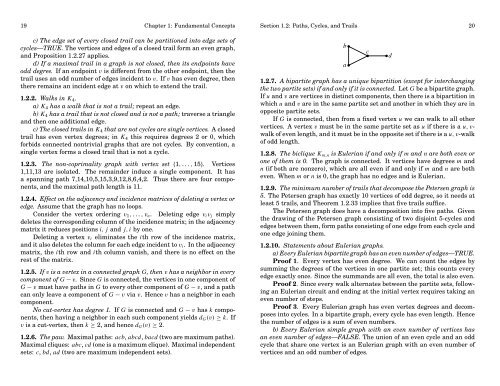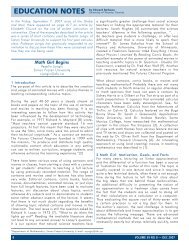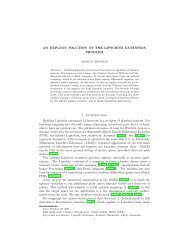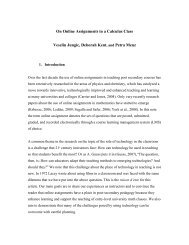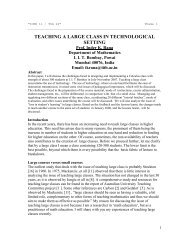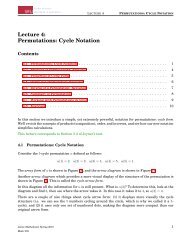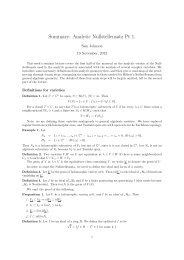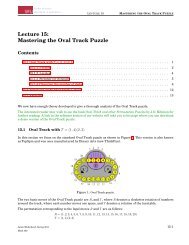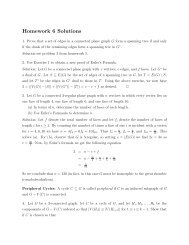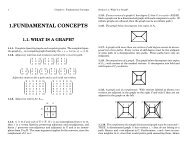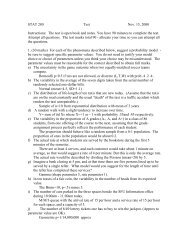1.2. PATHS, CYCLES, AND TRAILS - People.stat.sfu.ca
1.2. PATHS, CYCLES, AND TRAILS - People.stat.sfu.ca
1.2. PATHS, CYCLES, AND TRAILS - People.stat.sfu.ca
Create successful ePaper yourself
Turn your PDF publications into a flip-book with our unique Google optimized e-Paper software.
19 Chapter 1: Fundamental Concepts Section 1.2: Paths, Cycles, and Trails 20<br />
c) The edge set of every closed trail <strong>ca</strong>n be partitioned into edge sets of<br />
cycles—TRUE. The vertices and edges of a closed trail form an even graph,<br />
and Proposition <strong>1.2.</strong>27 applies.<br />
d) If a maximal trail in a graph is not closed, then its endpoints have<br />
odd degree. If an endpoint v is different from the other endpoint, then the<br />
trail uses an odd number of edges incident to v. If v has even degree, then<br />
there remains an incident edge at v on which to extend the trail.<br />
<strong>1.2.</strong>2. Walks in K4.<br />
a) K4 has a walk that is not a trail; repeat an edge.<br />
b) K4 has a trail that is not closed and is not a path; traverse a triangle<br />
and then one additional edge.<br />
c) The closed trails in K4 that are not cycles are single vertices. A closed<br />
trail has even vertex degrees; in K4 this requires degrees 2 or 0, which<br />
forbids connected nontrivial graphs that are not cycles. By convention, a<br />
single vertex forms a closed trail that is not a cycle.<br />
<strong>1.2.</strong>3. The non-coprimality graph with vertex set {1, . . . , 15}. Vertices<br />
1,11,13 are isolated. The remainder induce a single component. It has<br />
a spanning path 7,14,10,5,15,3,9,12,8,6,4,2. Thus there are four components,<br />
and the maximal path length is 11.<br />
<strong>1.2.</strong>4. Effect on the adjacency and incidence matrices of deleting a vertex or<br />
edge. Assume that the graph has no loops.<br />
Consider the vertex ordering v1, . . . , vn. Deleting edge vivj simply<br />
deletes the corresponding column of the incidence matrix; in the adjacency<br />
matrix it reduces positions i, j and j, i by one.<br />
Deleting a vertex vi eliminates the ith row of the incidence matrix,<br />
and it also deletes the column for each edge incident to vi. In the adjacency<br />
matrix, the ith row and ith column vanish, and there is no effect on the<br />
rest of the matrix.<br />
<strong>1.2.</strong>5. If v is a vertex in a connected graph G, then v has a neighbor in every<br />
component of G − v. Since G is connected, the vertices in one component of<br />
G − v must have paths in G to every other component of G − v, and a path<br />
<strong>ca</strong>n only leave a component of G − v via v. Hence v has a neighbor in each<br />
component.<br />
No cut-vertex has degree 1. If G is connected and G − v has k components,<br />
then having a neighbor in each such component yields dG(v) ≥ k. If<br />
v is a cut-vertex, then k ≥ 2, and hence dG(v) ≥ 2.<br />
<strong>1.2.</strong>6. The paw. Maximal paths: acb, abcd, bacd (two are maximum paths).<br />
Maximal cliques: abc, cd (one is a maximum clique). Maximal independent<br />
sets: c, bd, ad (two are maximum independent sets).<br />
b•<br />
a•<br />
c<br />
• •d<br />
<strong>1.2.</strong>7. A bipartite graph has a unique bipartition (except for interchanging<br />
the two partite sets) if and only if it is connected. Let G be a bipartite graph.<br />
If u and v are vertices in distinct components, then there is a bipartition in<br />
which u and v are in the same partite set and another in which they are in<br />
opposite partite sets.<br />
If G is connected, then from a fixed vertex u we <strong>ca</strong>n walk to all other<br />
vertices. A vertex v must be in the same partite set as u if there is a u, vwalk<br />
of even length, and it must be in the opposite set if there is a u, v-walk<br />
of odd length.<br />
<strong>1.2.</strong>8. The biclique Km,n is Eulerian if and only if m and n are both even or<br />
one of them is 0. The graph is connected. It vertices have degrees m and<br />
n (if both are nonzero), which are all even if and only if m and n are both<br />
even. When m or n is 0, the graph has no edges and is Eulerian.<br />
<strong>1.2.</strong>9. The minimum number of trails that decompose the Petersen graph is<br />
5. The Petersen graph has exactly 10 vertices of odd degree, so it needs at<br />
least 5 trails, and Theorem <strong>1.2.</strong>33 implies that five trails suffice.<br />
The Petersen graph does have a decomposition into five paths. Given<br />
the drawing of the Petersen graph consisting of two disjoint 5-cycles and<br />
edges between them, form paths consisting of one edge from each cycle and<br />
one edge joining them.<br />
<strong>1.2.</strong>10. Statements about Eulerian graphs.<br />
a) Every Eulerian bipartite graph has an even number of edges—TRUE.<br />
Proof 1. Every vertex has even degree. We <strong>ca</strong>n count the edges by<br />
summing the degrees of the vertices in one partite set; this counts every<br />
edge exactly once. Since the summands are all even, the total is also even.<br />
Proof 2. Since every walk alternates between the partite sets, following<br />
an Eulerian circuit and ending at the initial vertex requires taking an<br />
even number of steps.<br />
Proof 3. Every Eulerian graph has even vertex degrees and decomposes<br />
into cycles. In a bipartite graph, every cycle has even length. Hence<br />
the number of edges is a sum of even numbers.<br />
b) Every Eulerian simple graph with an even number of vertices has<br />
an even number of edges—FALSE. The union of an even cycle and an odd<br />
cycle that share one vertex is an Eulerian graph with an even number of<br />
vertices and an odd number of edges.


